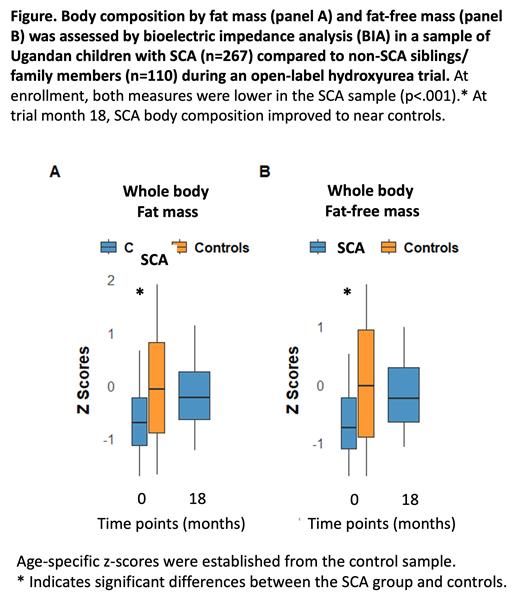Introduction
Children with sickle cell anemia (SCA) experience severe illness and risk of malnutrition in sub-Saharan Africa. Treatment with hydroxyurea (HU) decreases SCA complications. In high-income regions, hydroxyurea also improves pediatric growth and overall quality of life. We assessed the effects of hydroxyurea on growth and body composition of children with SCA in Uganda.
Methods
This study was nested in an open-label, single-arm pediatric clinical trial of hydroxyurea 20-30mg/kg/day for prevention of neurological and cognitive impairment. In all, 267 study participants with SCA, ages 3-9 years, initiated hydroxyurea treatment at the Mulago Hospital SCA Clinic in Kampala, Uganda. Anthropometric measurements (weight, height) were obtained at enrollment and at month 18 of therapy; age- and sex-specific z-scores were assigned, per World Health Organization (WHO) international standards. Non-invasive bioelectric impedance analysis (BIA), was used to estimate total body fat mass (FM) and fat-free mass (FFM) at both timepoints. A control sample of110 siblings/family members without SCA, aged 3-12 years, established local z-scores for BIA assessments.
Results
Among SCA participants and controls, 50.6% and 57.3% were female, respectively. Mean age was younger foror the SCA sample: 5.1±0.1 and 7.1±0.3 years ( p<.001). At trial month 18, mean hydroxyurea dose 25.4mg/kg, SCA hemoglobin rose from 7.8±1.2 to 8.9±1.5 g/dL( p<.001), remaining lower than mean hemoglobin level of non-SCA controls 12.5±1.1 ( p<.001). Using the World Health Organization definition of “wasting,” SCA participants at enrollment had a higher proportion of low weight-for-height than controls: 9.8% vs 3.8%, p=.009). By body composition, the SCA sample also had lower FFM (-0.67±0.56 vs. 0.00 ±1.00, p < .001) and FM (-0.68±0.60 vs. 0.00 ±1.00, p<.001) than controls. At month 18, for the 254 active SCA participants (95.1%), the proportion with wasting was unchanged. In contrast, z-scores for FFM (-0.65±0.57 to -0.16±0.57, p < .001) and FM (-0.66±0.61 to -0.18±0.61, p<.001) significantly increased (Figure) to near control levels.
Conclusion
Hydroxyurea therapy in children with SCA increased hemoglobin yet did not reduce the proportion with wasting after 18 months. Nonetheless, treatment led to significantly improved FM and FFM to near normal levels. These results suggest that hydroxyurea therapy may play a crucial role in enhancing body composition of children with SCA in the region. The ongoing hydroxyurea trial will enable assessment of longer-term impact on health-related growth and body composition in children with SCA in Uganda.
Disclosures
Green:AddMedica: Other: Donated study drug for an NIH-funded clinical trial.


This feature is available to Subscribers Only
Sign In or Create an Account Close Modal